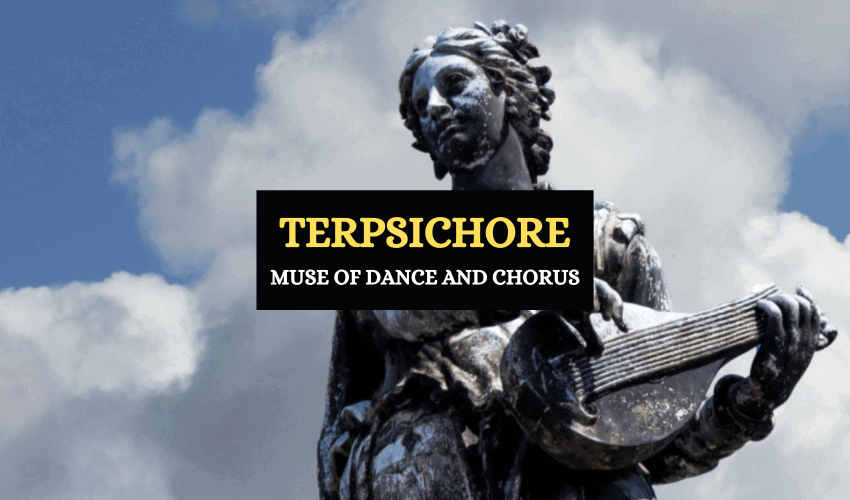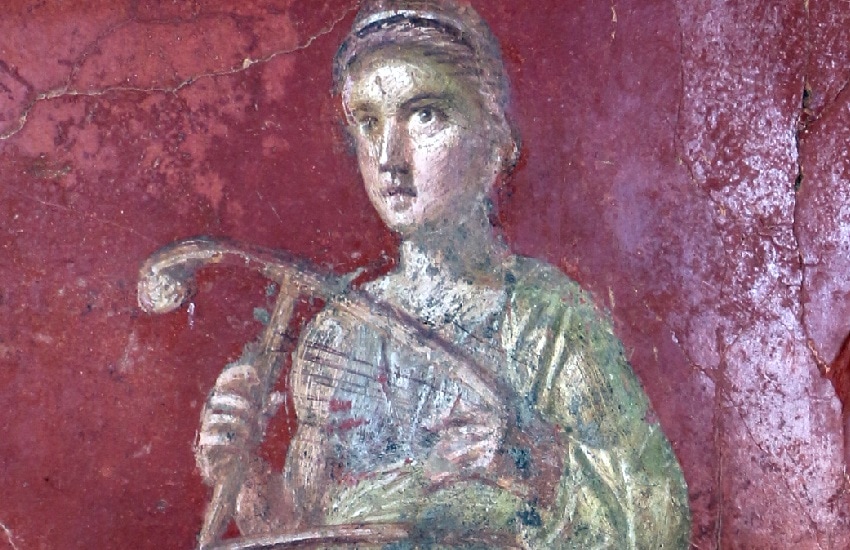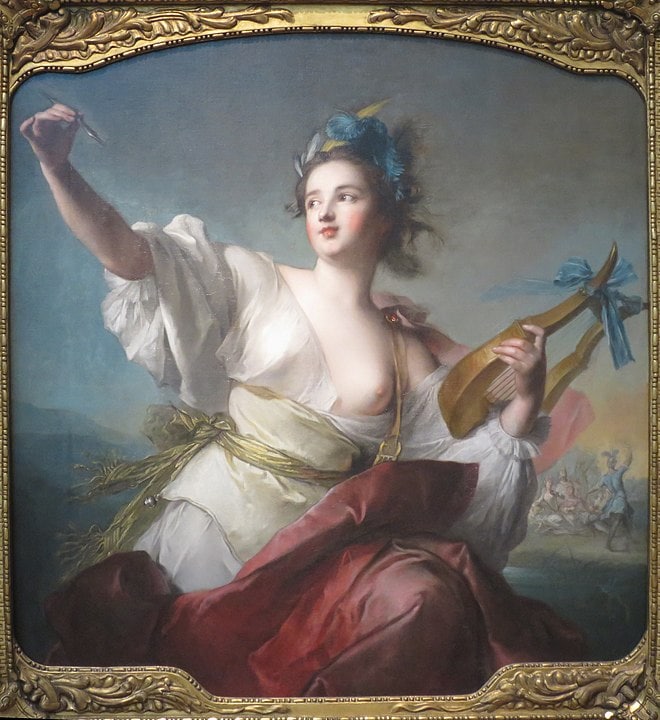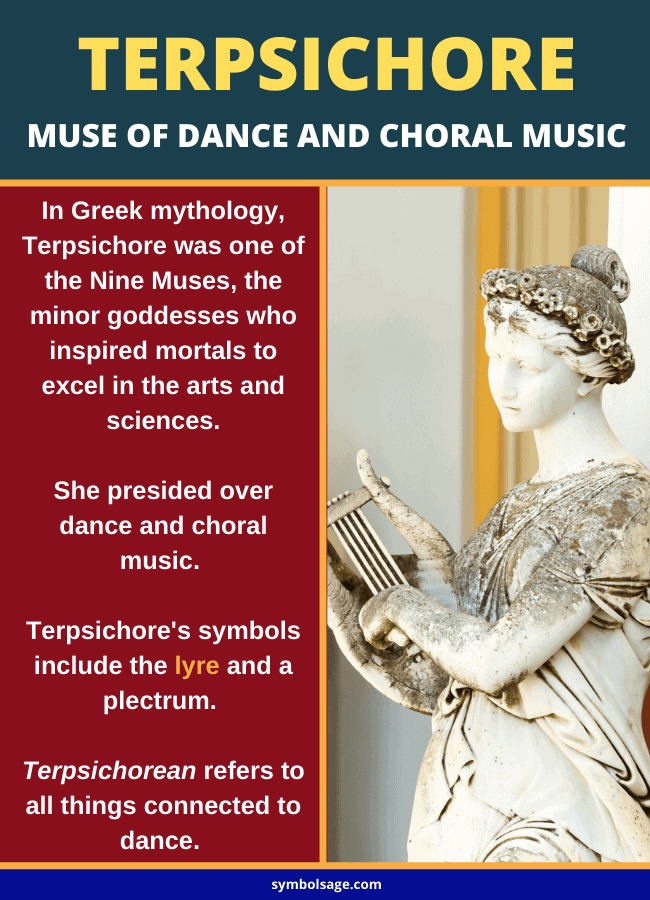
Table of Contents
In ancient Greece, there were nine goddess who were considered the rulers of all major artistic and literary spheres. These beautiful and intelligent goddesses were known as the Muses. Terpsichore was the Muse of music, song and dance and was likely the most famous of the Muses.
Who Was Terpsichore?
Terpsichore’s parents were the Olympian god of the sky, Zeus, and the Titanness of memory, Mnemosyne. The story goes that Zeus lay with Mnemosyne for nine nights in a row and she had nine daughters by him. Their daughters became famous as the Younger Muses, the goddesses of inspiration and the arts. Terpsichore’s sisters were: Calliope, Euterpe, Clio, Melpomene, Urania, Polyhymnia, Thalia and Erato.

Growing up, the Muses were taught by Apollo, the god of the sun and music, and nursed by the Oceanid Eupheme. Each of them was assigned a domain in the arts and sciences and each was given a name which reflect her domain. Terpsichore’s domain was music, song and dance and her name (also spelled as ‘Terpsikhore’) means ‘delight in dancing’. Her name is used as an adjective, terpsichorean, when describing things related to dance.
Like her sisters, Terpsichore was beautiful, as was her voice and the music she played. She was a highly talented musician who could play various flutes and harps. She’s usually portrayed as a beautiful young woman who’s seated, with a plectrum in one hand and a lyre in the other.
Terpsichore’s Children
According to the myths, Terpsichore had several children. One of them was Biston, who grew up to be a Thracian king and his father was said to be Ares, the god of war. According to Pindar, a Theban poet, Terpsichore had another son called Linus, who was famous as the legendary musician. However, some ancient sources state that it was either Calliope or Urania who bore Linus, and not Terpsichore.
In some accounts, the Muse of music is also regarded as the mother of the Sirens by the river god Achelous. However, some writers claim that it was not Terpsichore, but Melpomene, her sister, who mothered the Sirens. The Sirens were sea nymphs who were well-known for luring passing sailors to their doom. They were half-bird, half-maidens who had inherited their mother’s beauty and talents.

Terpsichore’s Role in Greek Mythology
Terpsichore wasn’t a central figure in Greek mythology and she never appeared in the myths alone. When she did appear in myths, it was always with the other Muses, singing and dancing together.
As the patron of music, song and dance, Terpsichore’s role in Greek mythology was to inspire and guide mortals to master the skills in her specific domain. Artists in ancient Greece prayed and made offerings to Terpsichore and the other Muses to benefit from their influence through which their arts could become true masterpieces.
Mount Olympus was the place where the Muses spent most of their time, entertaining the deities of the Greek pantheon. They presided over all events including feasts, marriages and even funerals. Their lovely singing and dancing was said to uplift everyone’s spirits and heal broken hearts. Terpsichore would sing and dance to heart’s content with her sisters and their performances were said to be truly beautiful and a delight to watch.
Terpsichore and the Sirens
Although Terpsichore was a lovely, good-natured goddess, she did have a fiery temper and anyone who slightened her or threatened her position was sure to face dire consequences. Her sisters were the same and when the Sirens challenged them to a singing contest, they felt insulted and angry.
According to the myths, the Muses (Terpsichore included) won the competition and punished the Sirens by plucking out all of the birds’ feathers to make crowns for themselves. It’s quite surprising that Terpsichore was involved in this as well, considering the fact that the Sirens were said to be her own children, but it shows that she wasn’t one to be played with.
Terpsichore’s Associations
Terpsichore is a highly popular Muse and she appears in the writings of many great authors.
The ancient Greek poet, Hesiod claimed to have met Terpsichore and her sisters, saying that they visited him when he was pasturing sheep on Mount Helicon which was where mortals worshipped the Muses. The Muses gifted him a laurel staff which is considered a symbol of poetic authority, and Hesiod subsequently dedicated the entire first section of Theogony to them. Terpsichore has also been mentioned in the Orphic Hyms and the works of Diodorus Siculus.

Terpsichore’s name gradually entered general English as ‘terpsichorean’, an adjective which means ‘pertaining to dancing’. It’s said that the word was first used in English in 1501.
The Muse of dance, song and music is also often depicted in paintings and other works of art, and is also a popular subject in the movie industry. Since the 1930s, she has been featured in several films and animations.
In Brief
Today, Terpsichore remains an important figure in the domain of dance, song and music. It’s said that in Greece, some artists still pray to her for inspiration and guidance in the arts. Her importance in Greek mythology points to the extent to which the ancient Greeks valued music, as a symbol of sophistication and civilization.








